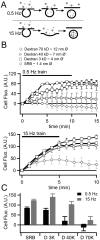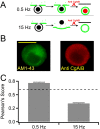Activity-dependent differential transmitter release in mouse adrenal chromaffin cells
- PMID: 16093382
- PMCID: PMC6725304
- DOI: 10.1523/JNEUROSCI.2042-05.2005
Activity-dependent differential transmitter release in mouse adrenal chromaffin cells
Abstract
Chromaffin cells of the adrenal medulla are a primary neuroendocrine output of the sympathetic nervous system. When stimulated, they secrete a host of transmitter molecules, including catecholamines and neuropeptides, through the fusion of dense core secretory granules with the cell surface. At basal firing rates, set by the sympathetic tone, chromaffin cells selectively release catecholamines at a modest rate. Stress-mediated sympathetic activation leads to elevated catecholamine secretion and also evokes neuropeptide release. Catecholamines and neuropeptides are copackaged in the same granules; thus, it is unclear how this activity-dependent differential transmitter release is achieved. In this report, we use electrophysiological, electrochemical, fluorescence, and immunocytochemical approaches to quantify transmitter release under physiological electrical stimulation at the single cell level. We provide data to show that chromaffin cells selectively release catecholamine under basal firing conditions but release both neuropeptides and catecholamines under conditions that match acute stress. We further show that this differential transmitter release is achieved through a regulated activity-dependent dilation of the granule fusion pore. Thus, chromaffin cells may regulate release of different transmitters through a simple size-exclusion mechanism.
Figures






Similar articles
-
Physiological stimulation regulates the exocytic mode through calcium activation of protein kinase C in mouse chromaffin cells.Biochem J. 2006 Oct 1;399(1):111-9. doi: 10.1042/BJ20060654. Biochem J. 2006. PMID: 16784416 Free PMC article.
-
Matching native electrical stimulation by graded chemical stimulation in isolated mouse adrenal chromaffin cells.J Neurosci Methods. 2007 Nov 30;166(2):195-202. doi: 10.1016/j.jneumeth.2007.07.004. Epub 2007 Jul 17. J Neurosci Methods. 2007. PMID: 17714791 Free PMC article.
-
Syndapin 3 modulates fusion pore expansion in mouse neuroendocrine chromaffin cells.Am J Physiol Cell Physiol. 2014 May 1;306(9):C831-43. doi: 10.1152/ajpcell.00291.2013. Epub 2014 Feb 5. Am J Physiol Cell Physiol. 2014. PMID: 24500282 Free PMC article.
-
Dynamin and myosin regulate differential exocytosis from mouse adrenal chromaffin cells.Cell Mol Neurobiol. 2010 Nov;30(8):1351-7. doi: 10.1007/s10571-010-9591-z. Cell Mol Neurobiol. 2010. PMID: 21061163 Free PMC article. Review.
-
Forty years of the adrenal chromaffin cell through ISCCB meetings around the world.Pflugers Arch. 2023 Jun;475(6):667-690. doi: 10.1007/s00424-023-02793-0. Epub 2023 Mar 8. Pflugers Arch. 2023. PMID: 36884064 Free PMC article. Review.
Cited by
-
Mechanisms of granule membrane recapture following exocytosis in intact mast cells.J Biol Chem. 2013 Jul 12;288(28):20293-305. doi: 10.1074/jbc.M113.459065. Epub 2013 May 24. J Biol Chem. 2013. PMID: 23709219 Free PMC article.
-
Transient fusion and selective secretion of vesicle proteins in Phytophthora nicotianae zoospores.PeerJ. 2013 Dec 3;1:e221. doi: 10.7717/peerj.221. eCollection 2013. PeerJ. 2013. PMID: 24392285 Free PMC article.
-
Differential SNARE chaperoning by Munc13-1 and Munc18-1 dictates fusion pore fate at the release site.Nat Commun. 2024 May 16;15(1):4132. doi: 10.1038/s41467-024-46965-7. Nat Commun. 2024. PMID: 38755165 Free PMC article.
-
Amperometry methods for monitoring vesicular quantal size and regulation of exocytosis release.Pflugers Arch. 2018 Jan;470(1):125-134. doi: 10.1007/s00424-017-2069-9. Epub 2017 Sep 27. Pflugers Arch. 2018. PMID: 28951968 Free PMC article. Review.
-
Integrating Optical and Electrochemical Approaches to Assess the Actions of Dynamin at the Fusion Pore.Methods Mol Biol. 2020;2159:163-178. doi: 10.1007/978-1-0716-0676-6_12. Methods Mol Biol. 2020. PMID: 32529370 Free PMC article.
References
-
- Albillos A, Dernick G, Horstmann H, Almers W, Alvarez de Toledo G, Lindau M (1997) The exocytotic event in chromaffin cells revealed by patch amperometry. Nature 389: 509-512. - PubMed
-
- Alvarez de Toledo G, Fernández-Chacón R, Fernández JM (1993) Release of secretory products during transient vesicle fusion. Nature 363: 554-558. - PubMed
-
- Angleson JK, Cochilla AJ, Kilic G, Nussinovitch I, Betz WJ (1999) Regulation of dense core release from neuroendocrine cells revealed by imaging single exocytotic events. Nat Neurosci 2: 440-446. - PubMed
-
- Aravanis AM, Pyle JL, Tsien RW (2003) Single synaptic vesicles fusing transiently and successively without loss of identity. Nature 423: 643-647. - PubMed
Publication types
MeSH terms
Substances
Grants and funding
LinkOut - more resources
Full Text Sources
Other Literature Sources
